Great Trek
The Great Trek (Afrikaans: Die Groot Trek; Dutch: De Grote Trek), starting in 1836 in southern Africa, was a mass migration of Dutch-speaking inhabitants of the British-run Cape Colony, who left the Cape and travelled eastward by wagon train, into the interior of the continent, in order to live beyond the reach of the British colonial administration. Both the Cape Colony and the area newly settled by the migrants later became part of what is today the country of South Africa.[1] The Great Trek was spurred by rising tensions between rural descendants of the Cape's original, mostly Dutch, European settlers, known collectively as Boers, and the later, mostly British, settlers, who had taken control of the Cape on behalf of the British Empire.[2] It was also spurred by an increasing yearning among members of the various Boer communities to live in a more isolationist, semi-nomadic way than had become possible in Cape Town, which was becoming much more administratively complex under British management.[3] Boers who took part in the Great Trek identified themselves as voortrekkers, meaning "pioneers" or "pathfinders" (literally "fore-trekkers") in Dutch and Afrikaans.
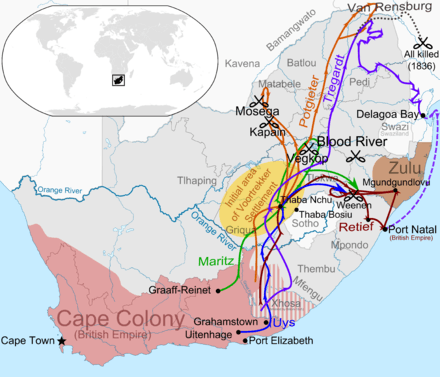
The Great Trek led directly to the founding of several autonomous Boer republics, namely the South African Republic (also known simply as the Transvaal), the Orange Free State, and the Natalia Republic.[4] It was also responsible for the displacement of the Northern Ndebele people,[5] and was one of several decisive factors influencing the decline and collapse of the Zulu Kingdom.[3]
Background
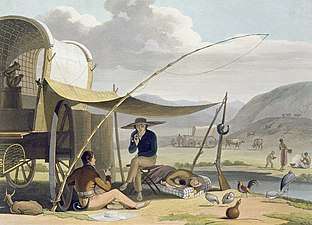
The Cape of Good Hope was first settled by Europeans in 1652, under the auspices of the Dutch East India Company (also known by its Dutch initials VOC), which established a victualling station there that year to give its outward-bound fleets fresh provisions and a harbour for refuge during the long sea journey from Europe to Asia.[6] Within a few decades, the Cape had become home to a large population of former Company employees who remained there after completing their contracts. This came about because the VOC released some employees from their contracts to save on their wages, instead offering them grants of farmland in exchange for their commitment that they would stay on the African continent for at least 20 years, and would cultivate grain on their land for the Company warehouses. To qualify for this arrangement, they had to be married, be considered "of good character" by the Company, and, except under special circumstances, be Dutch citizens.[6] These settlers were known as vrijlieden or vrijburgers (free citizens).[7] Vrijburgers were granted tax-exempt status for 12 years and were lent all the necessary seeds and farming implements they requested.[8] Reflecting the multinational character of the VOC’s workforce, some German soldiers and sailors were also granted vrijburger status,[6] and in 1688 the Dutch government sponsored the resettlement of over a hundred French Huguenot refugees at the Cape.[9] As a result, by 1691, more than a quarter of the colony's European population was not ethnically Dutch.[10] Nevertheless, there was a degree of cultural assimilation through intermarriage and the almost universal adoption of the Dutch language.[11] Cleavages were likelier to occur along social and economic lines than along national-origin lines. Broadly speaking, the Cape colonists fell into two categories: the rural Boers, poor farmers who settled directly on the frontier, and the Cape Dutch, who were more affluent and predominantly urban.[12]
In the late 1790s, following the Flanders Campaign and the Batavian Revolution in Amsterdam, the Dutch opened the Cape to French warships because France had helped establish a pro-French client state, the Batavian Republic, on Dutch soil.[2][3] Great Britain, seeing this as a threat to its own prosperous maritime shipping operations, seized control of the fledgling colony and occupied it by force until 1803.[2] From 1806 to 1814, the Cape was governed as a British military dependency, whose sole importance to the Royal Navy was its strategic relation to Indian maritime traffic.[2] Following the signing of the 1815 Treaty of Paris, the British formally assumed permanent administrative control of the colony.[2]
Causes
At the start of British rule, the Cape Colony encompassed 100,000 square miles (260,000 km2) and was populated by about 26,720 people of European descent. A majority of these were of Dutch extraction,[2][10] just over a quarter were of German ancestry, and about one-sixth were the descendants of French Huguenots,[10] most of whom had given up speaking French by around 1750.[11] The Colony’s population also included about 30,000 people of native African and Asian extraction who were being held in slavery by the Continental European settlers, and another 17,000 non-enslaved people who were indigenous Khoisan —- the descendants of those who had had the region to themselves before the coming of the Europeans. Relations between the new British administrators and many settlers of Continental European extraction – especially the Boers – were sour from the beginning.[4]
Another point of tension was the British government’s insistence that the Cape finance its own affairs through self-taxation, an approach which was alien both to the Boers and to the Dutch merchants in Cape Town.[3] Tensions escalated further in 1815, when the British police arrested a Boer farmer for allegedly assaulting one of his servants, provoking outrage among the Boers which resulted in the short-lived Slachter's Nek Rebellion. The British responded to the rebellion by hanging at least five Boers for insurrection.[2] The colony's Boer and merchant populations became further alienated from their British rulers in 1828, when the Cape‘s governor decreed that all members of the indigenous African population who were not enslaved would henceforth have the same citizenship rights, with respect to security and property ownership, as the descendants of European settlers.[2][13] Boer resentment of successive British administrators continued to grow throughout the late 1820s and early 1830s. Particularly difficult, from the Boers’ point of view, was Great Britain’s decision to change the colony’s official language from Dutch to English.[5] This change meant that English replaced Dutch as the language used in conducting the Cape’s judicial and political affairs, which put the Boers at a disadvantage, since most of them spoke little or no English.[2][13]
Great Britain's alienation of the Boers was further amplified by its decision to abolish slavery in all its colonies in 1834.[2][3] As a result of this decision, all 35,000 of the people registered with the Cape governor as enslaved were required to be freed and accorded the same rights as other citizens, although in most cases their former slaveholders were permitted to retain them as apprentices until 1838.[13][14] Many Boers, especially those involved with grain and wine production, had become economically dependent on slave labour. For example, 94% of all farmers of Continental European descent who lived in the vicinity of Stellenbosch held people as slaves, and there was a close correlation between the number of people each farmer enslaved and the size of his farm’s production output.[14] The British government offered to pay compensation to former slaveholders, but required them to travel to London to collect payment, and few Boers had enough money to make the trip.[3]
Boers who did not own farms, but pursued a semi-nomadic, pastoral way of life, were known as trekboers. They too were becoming increasingly frustrated by British rule, particularly the British government’s apparent unwillingness or inability to extend the borders of the Cape Colony eastward to give them access to more prime pasture and economic opportunities.
In response to these British intrusions into their way of life, and lack of responsiveness to their concerns, some members of the Boer community began migrating out of the colony and into South Africa’s unmapped interior, to avoid further disputes and live independently of British rule.[3][5]
Opposition
British officials viewed the Great Trek with trepidation.[12] They worried that the migration of Boers far into the interior of Southern Africa would inevitably result in conflict between the migrants and the Bantu peoples who were already living there.[12] However, the ostensible expression of these concerns at the time were likely more inspired by a latent desire to capture those territories for themselves in the near future, than for any sincere consideration of the well being of the Bantus, as the British authorities themselves were engaged in gradually capturing Xhosa territory by lethal force during 68 years of the Xhosa Wars in the decades leading up to, and following after, the Great Trek. Some worried that the migrants would enslave these indigenous people or otherwise reduce them to a state of penury.[15] But in the end, they decided that any intervention would be both costly and ineffective. Pursuing the migrants before such conflicts or harms could arise, and trying to re-impose an unpopular system of government on the migrants after they had deliberately rejected it, would come at a huge human and material cost; and intervening in conflicts between migrants and indigenous peoples would require the British government to launch a costly military operation.[12]
Around 12,000 people took part in the Great Trek migration, which was about one-fifth of the colony’s Dutch-speaking, ethnically European population at the time.[3][1] As a rule, members of the largely urban, relatively affluent Cape Dutch community remained. They were less likely to feel oppressed by British policies because, economically and culturally, they were not affected by them in the way the rural, farming-dependent Boers were.[12] They were more likely to have made their peace with British rule; indeed, many of them considered themselves loyal British subjects and even had a special affection for English culture.[16] However, many Boers also chose to remain in the Cape rather than participate in the Great Trek, despite their dislike of British rule,[4] and the Dutch Reformed Church, to which most of the Boers belonged, explicitly refused to endorse the Great Trek.[3]
Exploratory treks to Natal
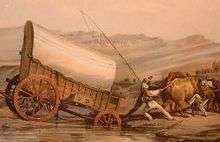
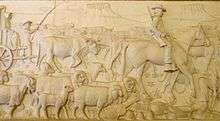
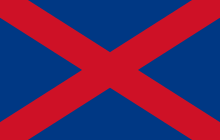
In January 1832, Dr. Andrew Smith (an Englishman) and William Berg (a Boer farmer) scouted Natal as a potential settlement. On their return to the Cape, Smith waxed very enthusiastic, and the impact of discussions Berg had with the Boers proved crucial. Berg portrayed Natal as a land of exceptional farming quality, well watered, and nearly devoid of inhabitants.
In June 1834, the Boer leaders of Uitenhage and Grahamstown discussed a Kommissietrek or "Commission Trek" to visit Natal and to assess its potential as a new homeland for the Cape Boers who were disenchanted with British rule at the Cape. Petrus Lafras Uys was chosen as trek leader. In early August 1834, Jan Gerritze set off with some travellers headed for Grahamstown 220 km away, a three-week journey from Graaff-Reinet. Sometime around late August 1834 Jan Bantjes arrived in Grahamstown, contacted Uys and made his introductions.
In June 1834 at Graaff-Reinet, Jan Gerritze Bantjes heard about the exploratory trek to Port Natal and, encouraged by his father Bernard Louis Bantjes, sent word to Uys of his interest in partaking in this great adventure. Bantjes wanted to help re-establish Dutch independence over the Boers and to get away from British law at the Cape. Bantjes was already well known in the area as an educated young man fluent both in spoken and written Dutch and in English. Because of these skills, Uys invited Bantjes to join him. Bantjes’s writing skills would prove invaluable in recording events as the journey unfolded.
On 8 September 1834, the Kommissietrek of 20 men and one woman, including a retinue of coloured servants, set off from Grahamstown for Natal with 14 wagons. Moving through the Eastern Cape, they were welcomed by the Xhosa who were in dispute with the neighbouring Zulu King Dingane ka Senzangakhona, and they passed unharmed into Natal. They travelled more or less the same route that Smith and Berg had taken two years earlier.
The trek avoided the coastal route, keeping to the flatter inland terrain. The kommissietrek approached Port Natal from East Griqualand and Ixopo, crossing the upper regions of the Mtamvuna and Umkomazi rivers. Travel was slow due to the rugged terrain, and since it was the summer, the rainy season had swollen many of the rivers to their maximum. Progress required days of scouting to locate the most suitable tracks to negotiate. Eventually, after weeks of incredible toil, the small party arrived at Port Natal, crossing the Congela River and weaving their way through the coastal forest into the bay area. They had travelled a distance of about 650 km from Grahamstown. This trip would have taken about 5 to 6 months with their slow moving wagons. The Drakensberg route via Kerkenberg into Natal had not yet been discovered.
They arrived at the sweltering hot bay of Port Natal in February 1835, exhausted after their long journey. There, the trek was soon welcomed with open arms by the few British hunters and ivory traders there such as James Collis, including the semi-invalid Reverend Allen Francis Gardiner, an ex-commander of the Royal Navy ship Clinker, who had decided to start a mission station there. After congenial exchanges between the Boers and British sides, the party settled in and invited Dick King to become their guide.
The Boers set up their laager camp in the area of the present-day Greyville Racecourse in Durban, chosen because it had suitable grazing for the oxen and horses and was far from the foraging hippos in the bay. Several small streams running off the Berea ridge provided fresh water for the trekkers. Alexander Biggar was also at the bay as a professional elephant-hunter and helped the trekkers with important information regarding conditions at Port Natal. Bantjes made notes suggested by Uys, which later formed the basis of his more comprehensive report on the positive aspects of Natal. Bantjes also made rough maps of the bay (this journal is now missing) showing the potential for a harbour which could supply the Boers in their new homeland.
At Port Natal, Uys sent Dick King, who could speak Zulu, to uMgungundlovu to investigate with King Dingaan the possibility of granting them land to settle. When Dick King returned to Port Natal some weeks later, he reported that King Dingaan insisted they visit him in person. Johannes Uys, brother of Piet Uys and a number of comrades with a few wagons, travelled toward King Dingaan’s capital at uMgungundlovu, and making a laager of wagons at the mouth of the Mvoti River, they proceeded on horseback, but were halted by a flooded Tugela River and forced to return to the laager.
The Kommissietrek left Port Natal for Grahamstown with a good stash of ivory in early June 1835, following more or less the same route back to the Cape, and arrived at Grahamstown in October 1835. On Piet Uys’s recommendation, Bantjes set to work on the first draft of the Natalialand Report. Meetings and talks took place in the main church to much approval, and the first sparks of Trek Fever began to take hold. From all the information accumulated at Port Natal, Bantjes drew up the final report on "Natalia or Natal Land" that acted as the catalyst which inspired the Boers at the Cape to set in motion the Great Trek.
First wave
| Largest first wave trek parties[15]:162–163 | ||||
|---|---|---|---|---|
| Leader | Date of departure | Point of departure | Size | |
| Louis Tregardt | September 1835 | Nine families including the Tregardt family | ||
| Hans van Rensburg | September 1835 | 49 | ||
| Hendrik Potgieter | late 1835 or early 1836 | Over 200 once united with the parties of Sarel Cilliers and Casper Kruger. | ||
| Gerrit Maritz | September 1836 | Graaff-Reinet | Over 700 people including roughly 100 white males | |
| Piet Retief | February 1837 | Albany | Roughly 100 men, women, and children. | |
| Piet Uys | April 1837 | Uitenhage | Over 100 members of the Uys family. | |
The first wave of Voortrekkers lasted from 1835 to 1840, during which an estimated 6,000 people (roughly 20% of the Cape Colony's total population or 10% of the white population in the 1830s) trekked.[15]
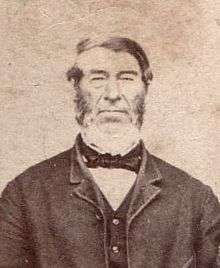
The first two parties of Voortrekkers left in September 1835, led by Louis Tregardt and Hans van Rensburg. These two parties crossed the Vaal river at Robert's Drift in January 1836, but in April 1836 the two parties split up, just seventy miles from the Zoutpansberg mountains, following differences between Tregardt and van Rensburg.[17]
A party led by Hendrik Potgieter trekked out of the Tarka area in either late 1835 or early 1836, and in September 1836 a party led by Gerrit Maritz began their trek from Graaff-Reinet. There was no clear consensus amongst the trekkers on where they were going to settle, but they all had the goal of settling near an outlet to the sea.[15]:162,163
In late July 1836 van Rensburg's entire party of 49, except two children (who were saved by a Zulu warrior), were massacred at Inhambane by an impi of Manukosi.[18] Those of Tregardt's party that settled around Soutpansberg moved on to settle Delagoa Bay, with most of the party, including Tregardt, perishing from fever.[15]:163
Conflict with the Matebele
In August 1836, despite pre-existing peace agreements with local black chiefs, a Ndebele (Matebele) patrol attacked the Liebenberg family part of Potgieter's party, killing six men, two women and six children. It is thought that their primary aim was to plunder the Voortrekkers' cattle. On 20 October 1836, Potgieter's party was attacked by an army of 4,600 Ndebele warriors at the Battle of Vegkop. Thirty-five armed trekkers repulsed the Ndebele assault on their laager with the loss of two men and almost all the trekkers' cattle. Potgieter, Uys and Maritz mounted two punitive commando raids. The first resulted in the sacking of the Ndebele settlement at Mosega, the death of 400 Ndebele, and the taking of 7,000 cattle. The second commando resulted in forcing Mzilikazi and his followers to flee to what is now modern day Zimbabwe.[15]:163
By spring (September/October) 1837, five to six large Voortrekker settlements had been established between the Vaal and Orange Rivers with a total population of around 2,000 trekkers.
Conflict with the Zulu
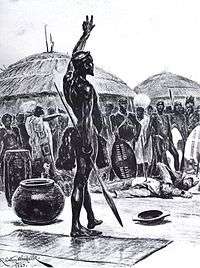
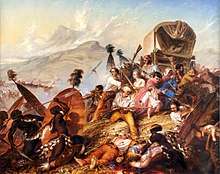
In October 1837 Retief met with Zulu King Dingane to negotiate a treaty for land to settle in what is now Kwa-Zulu Natal. King Dingane, feeling suspicious and insecure because of previous Voortrekker influxes from across the Drakensberg, had Retief and seventy of his followers killed.[15]:164
Various interpretations of what transpired exist, as only the missionary Francis Owen's written eye-witness account survived.[19] Retief's written request for land contained veiled threats by referring to the Voortrekker's defeat of indigenous groups encountered along their journey. The Voortrekker demand for a written contract guaranteeing private property ownership was incompatible with the contemporaneous Zulu oral culture which prescribed that a chief could only temporarily dispense land as it was communally owned.[20]
Most versions agree that the following happened: King Dingane's authority extended over some of the land in which the Boers wanted to settle. As prerequisite to granting the Voortrekker request, he demanded that the Voortrekkers return some cattle stolen by Sekonyela, a rival chief. After the Boers retrieved the cattle, King Dingane invited Retief to his residence at uMgungundlovu to finalise the treaty, having either planned the massacre in advance, or deciding to do so after Retief and his men arrived.
King Dingane's reputed instruction to his warriors, "Bulalani abathakathi!" (Zulu for "kill the wizards") showed that he may have considered the Boers to wield evil supernatural powers. After killing Retief's delegation, a Zulu army of 7,000 impis were sent out and immediately attacked Voortrekker encampments in the Drakensberg foothills at what later was called Blaauwkrans and Weenen, leading to the Weenen massacre in which 282 Voortrekkers, of whom 185 children were killed. In contrast to earlier conflicts with the Xhosa on the eastern Cape frontier, the Zulu killed the women and children along with the men, wiping out half of the Natal contingent of Voortrekkers.
The Voortrekkers retaliated with a 347-strong punitive raid against the Zulu (later known as the Flight Commando), supported by new arrivals from the Orange Free State. The Voortrekkers were roundly defeated by about 7,000 warriors at Ithaleni, southwest of uMgungundlovu. The well-known reluctance of Afrikaner leaders to submit to one another's leadership, which later hindered sustained success in the Anglo-Boer Wars, was largely to blame.
In November 1838 Andries Pretorius arrived with a commando of 60 armed trekkers and two cannon to assist in the defence. A few days later on the 16 December 1838, a force of 468 trekkers, 3 Britons, and 60 black allies fought against 10,000 to 12,000 Zulu impis at the Battle of Blood River. Pretorius's stunning victory over the Zulu army led to a civil war within the Zulu nation as King Dingane's half-brother, Mpande kaSenzangakhona, aligned with the Voortrekkers to overthrow the king and impose himself. Mpande sent 10,000 impis to assist the trekkers in follow-up expeditions against Dingane.[15]:164
After the defeat of the Zulu forces and the recovery of the treaty between Dingane and Retief from Retief's body, the Voortrekkers proclaimed the Natalia Republic.[21] After Dingane's death, Mpande was proclaimed king, and the Zulu nation allied with the short-lived Natalia Republic until its annexation by the British Empire in 1843.[15]:164[22]
The Voortrekkers' guns offered them an obvious technological advantage over the Zulu's traditional weaponry of short stabbing spears, fighting sticks, and cattle-hide shields. The Boers attributed their victory to a vow they made to God before the battle: if victorious, they and future generations would commemorate the day as a Sabbath. Thereafter, 16 December was celebrated by Boers as a public holiday, first called "Dingane's Day", later changed to the Day of the Vow. The name was changed to the Day of Reconciliation by the post-apartheid South African government, in order to foster reconciliation between all South Africans.[22]
Impact
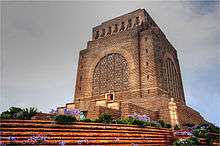
Conflict amongst the Voortrekkers was a problem because the trek leveled out the pre-existing class hierarchy which had previously enforced discipline, and thus social cohesion broke down. Instead the trek leaders became more reliant on patriarchal family structure and military reputation to maintain control over their parties. This had a large and lasting impact on Afrikaans culture and society.[15]:163
Centenary celebrations
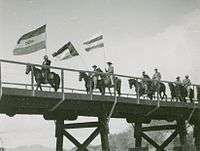
.jpg)
The celebration of the Great Trek in the 1930s play a major role in the growth of Afrikaans nationalism. It is thought that the experiences of the Second Boer War and the following period, between 1906 and 1934, of a lack of public discussion about the war within the Afrikaans community helped set the scene for a large increase in interest in Afrikaans national identity. The celebration of the centenary of the Great Trek along with a new generation of Afrikaners interested in learning about the Afrikaans experiences of the Boer War catalyzed a surge of Afrikaans nationalism.[15]:433
The centenary celebrations began with a re-enactment of the trek beginning on 8 August 1938 with nine ox wagons at the statue of Jan van Riebeeck in Cape Town and ended at the newly completed Voortrekker Monument in Pretoria and attended by over 100,000 people. A second re-enactment trek starting at the same time and place ended at the scene of the Battle of Blood River.[15]:432
The commemoration sparked mass enthusiasm amongst Afrikaners as the re-enactment trek passed through the small towns and cities of South Africa. Both participants and spectators participated by dressing in Voortrekker clothing, renaming streets, holding ceremonies, erecting monuments, and laying wreaths at the graves of Afrikaner heroes. Cooking meals over an open fire in the same way the Voortrekkers did became fashionable amongst urbanites, giving birth to the South African tradition of braaing.[15]:432 An Afrikaans language epic was made to coincide with the 100th anniversary of the Great Trek, Die Bou van 'n Nasie (1938). The film told the Afrikaans version of the history of South Africa from 1652 to 1910 with a focus on the Great Trek.[23]
A number of Afrikaans organisations such as the Afrikaner Broederbond and Afrikaanse Taal en Kultuurvereniging continued to promote the centenary's goals of furthering the Afrikaner cause and entrenching a greater sense of unity and solidarity within the community well into the 20th century.[15]:432[24]
Political impact
The Great Trek was used by Afrikaner nationalists as a core symbol of a common Afrikaans history. It was done in a way that promoted the idea of an Afrikaans nation and in a narrative that promoted the ideals of the National Party. In 1938, celebrations of the centenary of the Battle of Blood River and the Great Trek mobilized behind an Afrikaans nationalist theses. The narrative of Afrikaner nationalism was a significant reason for the National Party's victory in the 1948 elections. This in turn allowed the party to implement its stated program of apartheid. A year later the Voortrekker Monument was completed and opened in Pretoria by the newly elected South African Prime Minister and National Party member Daniel Malan in 1949.
A few years later, "Die Stem van Suid-Afrika", a poem written by Cornelis Jacobus Langenhoven referring to the Great Trek, was chosen to be the words of the pre-1994 South African national anthem. The post-1997 national anthem of South Africa incorporates a section of "Die Stem van Suid-Afrika" but it was decided to omit the section in "reference to the Great Trek (‘met die kreun van ossewa’), since this was the experience of only one section of our community."[25] When apartheid in South Africa ended and the country transitioned to majority rule, President F. W. de Klerk invoked the measures as a new Great Trek.[26]
In fiction
English
Literature
- H. Rider Haggard, Marie, novel, 1912.
- Stuart Cloete, Turning Wheels, novel, 1937.
- Helga Moray, Untamed, novel, 1950 - a 1955 movie of the same name is based on this book
- James A. Michener, The Covenant (1980)
- Robin Binckes, Canvas under the Sky, novel, 2011, ISBN 1920143637
- Controversial novel about a promiscuous drug-using Voortrekker set during the Great Trek.[27]
Film
- The Fiercest Heart (1961), movie
- Adventure/love story about two British soldiers who desert the military and join a group of Boers heading north on the Great Trek.
- Untamed (1955), movie
- Adventure/love story set in the later part of the trek about an Irish woman seeking a new life in South Africa after the Irish Potato famine. Based on a 1950 novel of the same name by Helga Moray.
Afrikaans
Literature
- Jeanette Ferreira
- Die son kom aan die seekant op (2007)[28]
- Geknelde land (English: Afflicted land) (1960)
- Offerland (English: Land of sacrifice) (1963)
- Gelofteland (English: Land of the covenant) (1966)
- Bedoelde land (English: Intended land) (1968)
References
- Laband, John (2005). The Transvaal Rebellion: The First Boer War, 1880-1881. Abingdon: Routledge Books. pp. 10–13. ISBN 978-0582772618.
- Lloyd, Trevor Owen (1997). The British Empire, 1558-1995. Oxford: Oxford University Press. pp. 201–206. ISBN 978-0198731337.
- Greaves, Adrian (17 June 2013). The Tribe that Washed its Spears: The Zulus at War (2013 ed.). Barnsley: Pen & Sword Military. pp. 36–55. ISBN 978-1629145136.CS1 maint: ref=harv (link)
- Arquilla, John (2011). Insurgents, Raiders, and Bandits: How Masters of Irregular Warfare Have Shaped Our World. Lanham: Rowman & Littlefield Publishing Group. pp. 130–142. ISBN 978-1566638326.
- Bradley, John; Bradley, Liz; Vidar, Jon; Fine, Victoria (2011). Cape Town: Winelands & the Garden Route. Madison, Wisconsin: Modern Overland, LLC. pp. 13–19. ISBN 978-1609871222.
- Hunt, John (2005). Campbell, Heather-Ann (ed.). Dutch South Africa: Early Settlers at the Cape, 1652-1708. Philadelphia: University of Pennsylvania Press. pp. 13–35. ISBN 978-1904744955.
- Parthesius, Robert. Dutch Ships in Tropical Waters: The Development of the Dutch East India Company (VOC) Shipping Network in Asia 1595-1660. Amsterdam: Amsterdam University Press. ISBN 978-9053565179.
- Lucas, Gavin (2004). An Archaeology of Colonial Identity: Power and Material Culture in the Dwars Valley, South Africa. New York: Springer, Publishers. pp. 29–33. ISBN 978-0306485381.
- Lambert, David (2009). The Protestant International and the Huguenot Migration to Virginia. New York: Peter Land Publishing, Incorporated. pp. 32–34. ISBN 978-1433107597.
- Entry: Cape Colony. Encyclopædia Britannica Volume 4 Part 2: Brain to Casting. Encyclopædia Britannica, Inc. 1933. James Louis Garvin, editor.
- Mbenga, Bernard; Giliomee, Hermann (2007). New History of South Africa. Cape Town: Tafelberg, Publishers. pp. 59–60. ISBN 978-0624043591.
- Collins, Robert; Burns, James (2007). A History of Sub-Saharan Africa. Cambridge: Cambridge University Press. pp. 288–293. ISBN 978-1107628519.
- Eric Anderson Walker (1963). The Cambridge History of the British Empire. CUP Archive. pp. 272, 320–2, 490. GGKEY:J4RZC934KC3.
- Simons, Mary; James, Wilmot Godfrey (1989). The Angry Divide: Social and Economic History of the Western Cape. Claremont: David Philip, Publisher (Pty) Ltd. pp. 31–35. ISBN 978-0864861160.
- Giliomee, Hermann (2003). The Afrikaners: Biography of a People. Cape Town: Tafelberg Publishers Limited. p. 161. ISBN 062403884X.
- Gooch, John (2000). The Boer War: Direction, Experience and Image. Abingdon: Routledge Books. pp. 97–98. ISBN 978-0714651019.
- Ransford, Oliver. The Great Trek. John Murray. Great Britain. 1972. Page 42.
- "Johannes Jacobus Janse (Lang Hans) van Rensburg, leader of one of the early Voortrekker treks, is born at the Sundays River". South African History Online. Archived from the original on 19 February 2014. Retrieved 24 August 2014.
- Bulpin, T.V. "9 - The Voortrekkers". Natal and the Zulu Country. T.V.Bulpin Publications.
- du Toit, André. "(Re)reading the Narratives of Political Violence in South Africa: Indigenous founding myths & frontier violence as discourse" (PDF). p. 18. Archived from the original (PDF) on 17 December 2008. Retrieved 18 August 2009.
- Bulpin, T.V. "11 - The Republic of Natal". Natal and the Zuku Country. T.V.Bulpin Publications.
- "Battle of Blood River". Encyclopædia Britannica. Retrieved 21 May 2010.
- "Die Bou van 'n Nasie". IMDb. Retrieved 1 March 2015.
- "Great Trek Centenary Celebrations commence". South African History Online. Retrieved 31 December 2014.
- "The national anthem is owned by everyone". South African Music Rights Organisation. 17 June 2012. Retrieved 8 January 2015.
- "South Africa approves new constitution to end white rule. (Originated from Knight-Ridder Newspapers)". 22 December 1993. Archived from the original on 19 September 2018. Cite journal requires
|journal=(help) - Kevin Ritchie (11 February 2012). "Mad Boers burn Great Trek bodice ripper". IOL News. Retrieved 1 March 2015.
- Ferreira, Janette (2007). Die son kom aan die seekant op. Human & Rousseau.